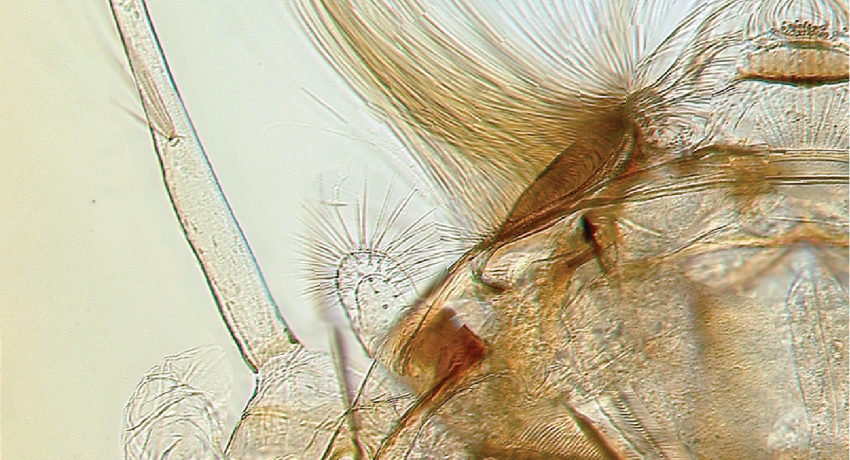NEARCTIC & NEOTROPICAL REGION
Generic abbreviation: De.
Type species: Deinocerites cancer Theobald, 1901c
Etymology: not stated [terrible, fearful horn (Gr); poss. ref. to stout setae on gonocoxite]
Mosquitoes of the genus Deinocerites most closely resemble Culex, however they are distinguished in that in Deinocerites the maxillary palpus is very short, the antenna much longer than the proboscis, and the first antennal flagellomere is usually very long. Deinocerites cancer Theobald is the type species of the genus, that currently includes only 18 described species. Deinocerites species are restricted to the Neotropics, but the ranges of De. cancer, De. mathesoni Belkin & Hogue and De. pseudes Dyar & Knab, extend into the southern United States.
DIAGNOSTIC CHARACTERS (Click photos to view; mouse over and click large photo to zoom in.)
ADULT (illustrated): Head: Flm1 usually very long; antenna considerably longer than proboscis; palpus very short.
LARVA (not illustrated): Head: Head with distinct lateral expansion, at least as wide as long, widest at insertion of antennae; base of mandible with distinct, highly spiculose lobe. Terminal segments: Pecten with 2–3 branched pecten spines; saddle with ill-defined separate dorsal and ventral plates.
TAXONOMIC KEYS
Adames 1971
![]()
WRBU – Genera – Global – Larva
![]()
WRBU – Genera – Neotropical – Adult
![]()
WRBU – Genera – Neotropical – Larva
Exemplar DNA sequences
De. atlanticus COI: MF179287–306
De. magnus COI: MH376751–752
All Deinocerites DNA sequences
BIONOMICS
Immatures
Immatures Deinocerites are almost always found in crabholes, and rarely in artificial containers, and in small rock holes and tree holes. Deinocerites pseudes individually dot their eggs to the sides of the crabholes, just above the waterline; adults often rest on the walls of these humid sites.
Adults
In Panama, De. pseudes, De. epitedeus (Knab) and De. cancer feeds on mammals, man and birds, as well as reptiles and amphibians, whereas D. melanophylum Dyar & Knab, and D. dyari Belkin & Hogue, preferred reptilian bloods. In Colombia, host-seeking De. atlanticus Adames were collected in Shannon traps set close to rural forest patches, farms and mangroves in the early evening (18:00–21:00). Only one species is of biomedical importance—Deinocerites pseudes— a vector of St. Louis and Venezuelan Equine Encephalitis viruses.
*Associated pathogens: This list reports bacteria, viruses, and parasites recovered from, or experimentally passed through this species, and does not imply field vector status.
IMPORTANT REFERENCES (full citations below)
Theobald 1901a: 98 (as genus)
Theobald 1901b: 235 (as genus)
Theobald 1901c: 215 (as genus)
Belkin & Hogue 1959 (revision)
Belkin et al. 1970 (taxonomy, bionomics; Jamaica)
Adames 1971 (revision; taxonomy, keys, bionomics)
Navarro & Liria 2000 (L mouthparts*; phylogeny; as subgenus of genus Culex)
Harbach et al. 2012 (phylogeny)
VALID SUBGENERA
None
CURRENT GENERIC SYNONYMS
syn. Brachiosoma Theobald 1901b: 235 (as genus). Type species: Deinocerites cancer Theobald (Coquillett 1910: 515). Blanchard 1905: 414 (synonymy).
syn. Brachiomyia Theobald 1901c: 343. Type Species: Brachiomyia magna Theobald. Theobald 1903a: 275 (synonymy).
syn. Deinokerides Giles 1902: 472 (unjustified emendment).
syn. Dinocerites Blanchard 1905: 413 (unjustified emendment of Deinocerites).
syn. Dinomimetes Knab 1907b: 120. Type species: Dinomimetes epitedeus Knab. Dyar 1918b: 101 (synonymy).
syn. Dinanamesus Dyar & Knab 1909d: 259 (as genus). Type Species: Dinanamesus spanius Dyar & Knab.
CITED REFERENCES
Adames, A.J. (1971). Mosquito studies (Diptera, Culicidae). XXIV. A revision of the crabhole mosquitoes of the genus Deinocerites. Contributions of the American Entomological Institute, 7(2), 1–154.
Belkin, J.N., & Hogue, C.L. (1959). A review of the crabhole mosquitoes of the genus Deinocerites (Diptera, Culicidae). University of California Publications in Entomolgy, 14(6), 411–458.
Belkin, J.N., Heinemann, S.J., & Page, W.A. (1970). The Culicidae of Jamaica (Mosquito studies. XXI). Contributions of the American Entomological Institute, 6(1), 458.
Blanchard, R. (1905). Les moustiques, histoire naturelle et médicale. F. R. de Rudeval, Imprimeur-Editeur, Paris. 673 pp.
Dyar, H.G. (1918b). A revision of the American species of Culex on the male genitalia. Insecutor Inscitiae Menstruus, 86–111.
Dyar, H.G., & Knab, F. (1909d). Descriptions of some new species and a new genus of American mosquitoes. Smithsonian Miscellaneous Collections, 52(1822), 253–266.
Giles, G.M. (1902). A handbook of the gnats or mosquitoes giving the anatomy and life history of the Culicidae, together with descriptions of all species notices up to the present date. J. Bale, sons & Danielsson, Limited, London, 530pp.
Harbach, R.E., Kitching, I.J., Culverwell, C.L., Dubois, J., & Linton, Y.-M. (2012). Phylogeny of mosquitoes of tribe Culicini (Diptera: Culicidae) based on morphological diversity. Zoologica Scripta, 41(5), 499–514.
Knab, F. (1907b). A new genus and species of sabethid mosquito. Journal of the New York Entomological Society, 15, 120–121.
Navarro, J.C., & Liria, J. (2000). Phylogenetic relationships among eighteen neotropical Culicini species. Journal of the American Mosquito Control Association, 16(2), 75–85.
Theobald, F.V. (1901a). A monograph of the Culicidae or mosquitoes (Vol. 1). London: British Museum (Natural History). [424pp]
Theobald, F.V. (1901b). The classification of mosquitoes. Journal of Tropical Medicine, 4, 229–235.
Theobald, F.V. (1901c). A monograph of the Culicidae or mosquitoes (Vol. 2). London: British Museum (Natural History). with Atlas of 37 colored pls. + 5 pls. of photographs.
Theobald, F.V. (1903a). A monograph of the Culicidae of the World (Vol. 3). London: British Museum (Natural History). 359pp
CITE THIS PAGE
Walter Reed Biosystematics Unit (Year). Deinocerites genus page. Walter Reed Biosystematics Unit Website, http://wrbu.si.edu/vectorspecies/genera/deinocerites, accessed on [date (e.g. 03 February 2020) when you last viewed the site].





